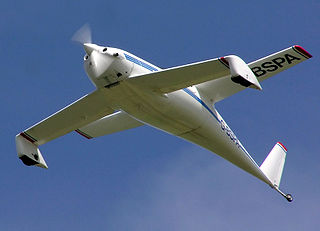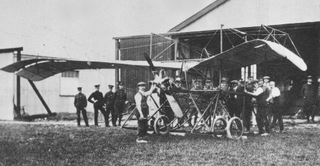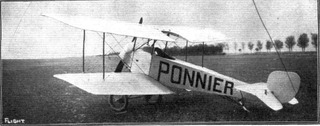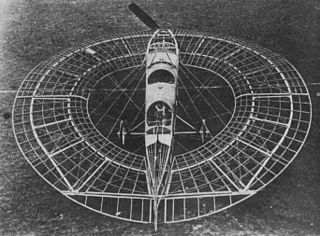Description
The main feature of the design was a set of three wings, each of 10 ft (3.0 m) chord, placed immediately fore and aft of each other. The fore-wing was of reduced span and the middle wing raised to give the appearance of a heavily staggered canard biplane. The angle of incidence of each plane was adjusted to provide longitudinal stability.
The outer sections of the rear wing were given a sharp downward angle or anhedral. Triangular outboard control surfaces were hinged on the diagonal to these sections and provided all the functions normally produced by separate elevator, aileron and rudder controls. When operated together they acted as elevators, while when operating differentially they acted as combined ailerons and rudders to bank the aircraft into a controlled turn.
The front and rear wings were fixed to a long, uncovered fuselage frame, with the front wing gently tapered. The top wing was strut-braced to the structure below. Side curtains between the two full-span wings were initially fitted. [3]
The pilot was seated above the front wing, with the engine immediately behind. Power was initially provided by a single Wolseley water-cooled inline engine chain-driving twin propellers. These were mounted in the space beneath the upper wing and their axles doubled as twin cylindrical booms connecting the fore and aft structures.
When first flown at Eastchurch in early 1910, the fuselage was originally mounted on an undercarriage comprising two main wheels, a large tail wheel and twin auxiliary skids under the nose. [3]
Later modifications included removal of the side screens, structural lightening including a revised undercarriage and, in 1913, fitting of a more powerful 70 hp (52 kW) Gnome air-cooled rotary engine with single engine-mounted propeller. [4] These enabled the craft to reach 43 mph (69 km/h; 37 kn). [1] [2]

John William Dunne was a British soldier, aeronautical engineer and philosopher. As a young man he fought in the Second Boer War, before becoming a pioneering aeroplane designer in the early years of the 20th century. Dunne worked on automatically stable aircraft, many of which were of tailless swept wing design, to achieve the first certified stable aircraft. He later developed a new approach to dry fly fishing before turning to speculative philosophy, where he achieved some prominence and literary influence through his "serialism" theory on the nature of time and consciousness, explained in his book An Experiment with Time.

A triplane is a fixed-wing aircraft equipped with three vertically stacked wing planes. Tailplanes and canard foreplanes are not normally included in this count, although they occasionally are.

A tandem wing is a wing configuration in which a flying craft or animal has two or more sets of wings set one behind another. All the wings contribute to lift.

The Bristol T.B.8, or Bristol-Coanda T.B.8 was an early British biplane built by the Bristol Aeroplane Company and designed by the Romanian Henri Coandă. Fifty four Bristol T.B.8s were built, being mainly used as a trainer. A small number of Bristol T.B.8s were briefly used as bombers at the start of the World War I by the Royal Naval Air Service.
The Sopwith Two-Seat Scout was a 1910s British biplane Anti-Zeppelin scout biplane designed and built for the Admiralty by the Sopwith Aviation Company. It was nicknamed the Spinning Jenny due to a tendency to enter a spin.

The Blackburn Triplane was a single-engine pusher single-seater, designed specifically to attack Zeppelins. It flew in 1917, but was not successful.

The Bristol B.R.7 was a Romanian-designed single-engine two-seat biplane built by Bristol to a Spanish government order in 1913. It failed to meet its specifications and the order was cancelled.
The Sopwith Three-seater was a British aircraft designed and built prior to the start of the First World War. One of the first aircraft built by the Sopwith Aviation Company, it was operated by both the Royal Naval Air Service (RNAS) and the Royal Flying Corps (RFC), being used briefly over Belgium by the RNAS following the start of the War.
The Boulton & Paul P.12 Bodmin was an experimental British twin-engined biplane bomber with its engines mounted in a fuselage engine room and with tandem pairs of tractor and pusher airscrews mounted between the wings. The two Bodmins built flew in 1924, proving the concept but the layout was not developed to production.

The Dunne D.8 of 1912 was a tailless swept wing biplane, designed by J. W. Dunne to have inherent stability. One example was supplied to RAE Farnborough. License-built Burgess-Dunne models were used by the US Signal Corps and United States Navy and the short-lived Canadian Aviation Corps. It was the latter's first and only warplane.

The Dunne D.7 was one of J. W. Dunne's swept wing tailless aircraft designed to have automatic stability, first flying in 1911. It was a single seat, single engined pusher monoplane developed from the unsuccessful D.6.

The Short S.27 and its derivative, the Short Improved S.27, were a series of early British aircraft built by Short Brothers. They were used by the Admiralty and Naval Wing of the Royal Flying Corps for training the Royal Navy's first pilots as well as for early naval aviation experiments. An Improved S.27 was used by C.R. Samson to make the first successful take-off from a moving ship on 9 May 1912.

The ASL Viking was a single-engined two seater biplane aircraft designed and built by Horatio Barber's Aeronautical Syndicate Ltd. at Hendon. It was first flown in January 1912.

The Siemens-Schuckert DDr.I was a World War I German twin engine, push-pull configuration triplane fighter aircraft. Only one was built, crashing on its first flight.

The Short S.36 was a British two-seat tractor biplane, built by Short Brothers for Francis McClean in 1911. It was later developed into the Short S.41 and Short S.45, which were the first of a long series of similar aircraft built for the RNAS and RFC.

The Paalson Type 1, (Pålson), was a Swedish single-seat sport aircraft built around 1920. It was of conventional single-seat biplane layout but had some unusual features such as girder type interplane struts, a novel main undercarriage axle mounting and a mechanism allowing adjustment of the angle of incidence of the upper wing.

The Ponnier L.1 was an early French biplane single seat scout, built just before World War I. It did not reach production.

The Schütte-Lanz G.I was a large, twin engine, pusher configuration, experimental biplane built in Germany early in World War I. Only one was completed.
The Euler Hydro-triplane was an unusual pusher configuration amphibious triplane flying boat, built in Germany in 1913.

During the pioneer years before the First World War, Cedric Lee and G. Tilghman Richards in the UK built and flew a series of aircraft having a novel flat ring-shaped or annular wing. They built both biplane and monoplane types, and in 1913 their first monoplane proved to be an early example of a statically stable aircraft.
This page is based on this
Wikipedia article Text is available under the
CC BY-SA 4.0 license; additional terms may apply.
Images, videos and audio are available under their respective licenses.
















